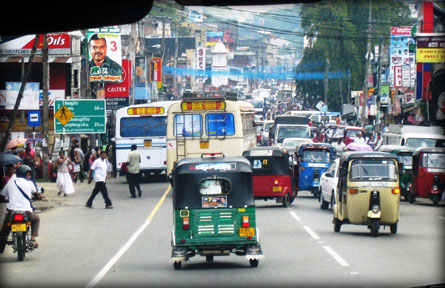Lane discipline
 While
driving on the Parliament Road recently, I saw a new traffic board
erected by the Police which proclaimed that the 'Lane Discipline Law is
Active'. This naturally begs the question as to why the law was not in
effect all this time, but as the saying goes "better late than never".
This was a long felt need, an essential step to streamline the flow of
traffic which is mostly horrendous in Colombo. While
driving on the Parliament Road recently, I saw a new traffic board
erected by the Police which proclaimed that the 'Lane Discipline Law is
Active'. This naturally begs the question as to why the law was not in
effect all this time, but as the saying goes "better late than never".
This was a long felt need, an essential step to streamline the flow of
traffic which is mostly horrendous in Colombo.
Actually, this is not the first time that the lane law was practised
in this country. It has been in effect for a few years on the Colombo-Katunayake
normal road (not the Expressway), where vigilant policemen book drivers
of trucks, buses and three wheelers which occupy the fast lane even
briefly. The presence of slow moving vehicles on the right lane is a
hindrance to faster vehicles such as cars, SUVs and pick-up trucks.
Since most drivers of slow moving vehicles on this road have now learned
not to cross lines, so to speak, the hard way, the drive is mostly
smooth and hassle free for other motorists. Even if one does not use the
Expressway, it is still possible to take the normal road and go to the
airport on time thanks to the lane discipline observed on this road.
Priority
The Police should have introduced the same process to other roads in
all provinces much sooner. The Western Province has the highest number
of vehicles so priority should be given to implementing the lane
discipline laws there first. If motorists know that the Police are very
strict about lane discipline, they will drive carefully. Right now, the
Police usually book drivers who cross the single or double continuous
white line (in doing so, the motorist actually uses the lane reserved
for oncoming traffic), but when the lane discipline law is strictly
implemented, they can take action against motorists who do not stick to
the correct lane even on their side of the road.
However, motorists will need a little time - and guidance - to take
it in. Over time, laws become second nature to people and they adhere to
them without thinking twice. The seat belt law is a good example. Now
everyone buckles up before they begin to drive, without necessarily
thinking about the police or the law itself. All motorists observe the
pedestrian-crossing laws now, because it is more or less ingrained in
their minds.
|

A common scene in the city |
The police seem to be doing a good job with the new lane discipline
laws, by placing boards that urge motorists to stick to the proper lanes
and also warnings such as 'right lane must turn right' and 'left lane
must turn left' (so that those who want to go straight will avoid that
lane and use the middle or left lane).
Destination
This is essential because some motorists do not plan ahead with
regard to the lane they have to travel to reach a particular
destination. For example, it generally makes sense to be on the right
lane if you want to turn right. We have seen plenty of motorists who try
to turn right from the left lane and also others who want to go straight
but stay on the right lane. When they realize they are on the incorrect
lane, they hastily try to turn to the other lane, which blocks those who
want to go straight when the lights turn green. Thus, from a motorist's
point of view, it makes sense to know exactly where you are going and
which lanes will take you there faster. A little bit of planning can
take away a lot of hassle.
Annoying
The other annoying factor is that many motorists, especially three
wheeler drivers and motorcyclists, switch lanes abruptly without
signalling, which can cause an accident because the drivers following
behind get no clue at all about such an intention until the very last
second. Signalling is a must when switching lanes and the failure to do
so is considered an offence in many countries. Worse, many three wheeler
drivers make U-turns without signalling at all, which is highly
dangerous since traffic on both sides of the road is affected. The
police should keep an eye on such activities too.
Technology can also help motorists to keep to their lanes. Many new
premium cars have pre-installed Lane Departure Warning Systems which
gives visible and audible warnings to drivers if they stray to another
lane without signalling first. These cars have cameras which scan the
road ahead and provide feedback to the vehicle's onboard computers which
deliver this crucial message to the driver. The technology is now
filtering down to more mainstream cars as an optional feature as
manufacturers realize economies of scale. Motorists should check whether
their new cars have this important feature at the point of ordering or
purchase, because it really can save lives.
Congested
In the near future, cars and interactive road signs will be able to
communicate with each other and once you input the destination, the car
will be able to 'talk' to the traffic signs and get a less congested
route. This will also minimize or traffic accidents as computers do not
get tired or dizzy even after 'driving' or long periods.
They are not likely to switch lanes accidentally and cause an
accident. The most ideal scenario is an 'intelligent' driving
environment in smart cities and urban areas where autonomous cars and
interactive road signs take you safely to your destination. This is
likely to happen in around 20 years and some of us will be around to
experience the ride.
In the meantime, it is up to us to maintain lane discipline on our
congested roads. The police cannot be everywhere and it defeats the very
purpose of the law if we stick to the lanes only in fear of the police.
The law has been implemented for the protection of all road users
including pedestrians. It is in our best interest to literally know
where we are going and plan ahead. |

